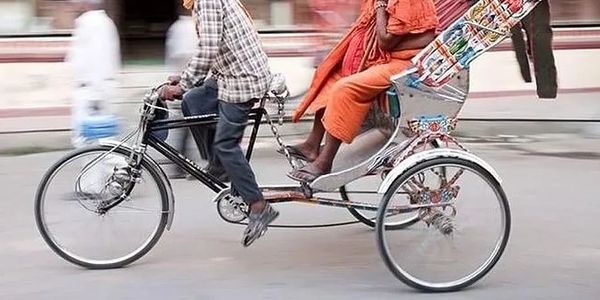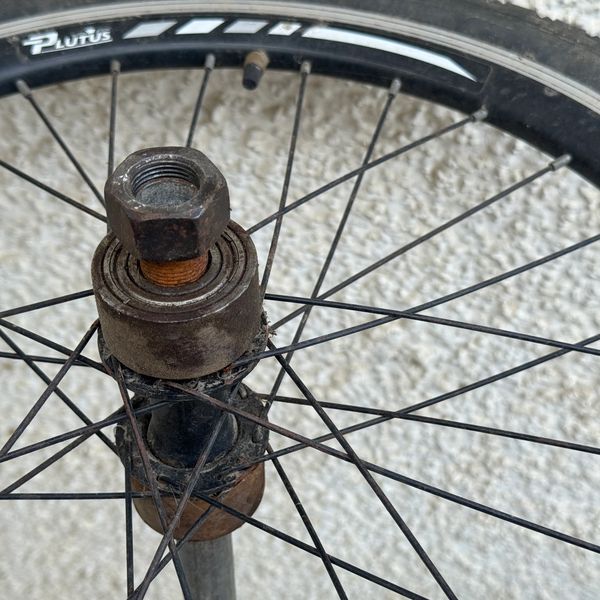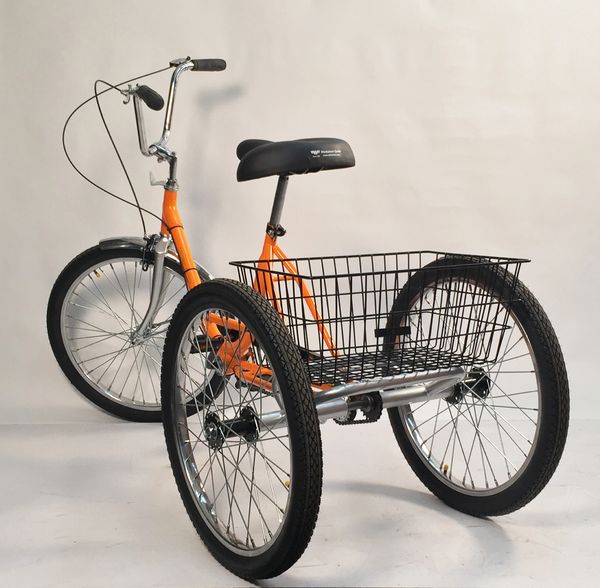Signed in as:
filler@godaddy.com
Signed in as:
filler@godaddy.com

Background
Load-carrying trikes are quite common in India.
A basic design has been in use, unmodified for more than a hundred years. The chassis of this tricycle is created by taking a roadster bike, removing the rear wheel and the rear part of the frame (behind the seat-post) and adding a heavy iron triangular frame that is connected to the bottom-bracket at the base of the bicycle frame and a heavy solid iron axle at the back.
The weight of such a trike is about 60kg. It can be used to pull loads of 500kg but at very slow speeds (3km per hour). This design has been used both for passenger transport (2 people) and for transporting loads.
Our weight target
We are designing a lightweight trailer starting with the same bicycle frame as was used in the trike design. It is a trailer attachment to a bicycle and not a trike. It weighs about 10kg.

Since the trailer is being designed for speed, we try to keep the weight of the load close to the center line of the trailer and we focus more on longitudinal stability than lateral balance.
Longitudinal Stability Axle
The primary axle of the trailer provides shock absorption and serves to stabilize the weight of the load behind the rider.
It is as narrow as possible and has 4 heavy-gauge 14" wheels in 2 pairs.
Lateral Balance Axle
The trailer also has a secondary axle which is wide and lightweight. It has a low pressure contact with the ground add serves to balance the load laterally. It also helps turn the trailer.

We use heavy duty wheels for the longitudinal stabilizer and lightweight wheels for the lateral balancer. Additional shock absorbers could be added.

A modern commercial trike design is shown in the picture above.
Such a design removes the rear-wheel and replaces it with a 2-wheel axle at the same location. Hence, it has the riding characteristics of a bicycle and the additional stability and load-carrying capacity of a tricycle.
We target a bicycle-attachment type design with similar ruggedness and durability characteristics.

The trailer consists of two axles.

We modify a stock 14in or 16in wheel in the following way:

All structural elements (for pulling, steering, strengthening and frame-building) are made using rectangular cross-section (40mm x 8mm), hollow (2mm gauge) steel beams. Weight is about 1.6kg/m.
These beams are strengthened at their attachment points with iron plate segments. A 4mm thick iron plate segment fits inside the beam and two 2mm thick plate segments sandwich it from the outside. The 3 plates and beam section are aligned, bored through with 2mm holes and riveted. (This keeps weight low while providing strength where needed).

Send us an email mentioning:
1. A position (described below or defined by you).
2. Your qualification for that position (level of interest).
3. Any questions regarding the nature of the technologies and markets involved.
We will reply on the same day.
All positions are hybrid. You can choose where you will work and decide how to meet other workers.
There are no workers other than me at this time.

You will manage the marketing of a land-vehicle or PC related product.
1.
Bicycle-trailer design.
The design is intended for industrial or commercial use, not recreational.
The trailer is non-motorized and designed to carry medium-heavy loads at slow speeds.
2.
The Specifier industrial-design specification desktop-app for industrial designers.
Established tools in this domain are Solidworks-3DExperience and Autodesk-Alias.
It's a large and mature market of about $40 billion worldwide.
3.
InterUnit-UI
You will test InterUnit-UI apps and manage the marketing of the InterUnit-UI SDK for Windows, MacOS and Linux.

You will port an existing C++ SDK for InterUnit-UI based on wxWidgets on MacOS to a native Swift SDK on MacOS.
You will maintain both these SDKs.
You will support the development of MacOS apps based on InterUnit-UI.

You will port an existing app-development C++ SDK (C++) for InterUnit-UI that targets the cross-platfrom wxWidgets library to a C++ SDK in C++ that targets Win32.
You will maintain and update both these SDKs.
You support the development of InterUnit-UI apps on Windows.

You will maintain the Linux version of the InterUnit-UI SDK which is currently being implemented using wxWidgets.
You will verify and support its operation on different versions of Linux.
You will explore alternative ways to implement this SDK natively on Linux.
You will support the development of InterUnitUI based apps on Linux.

You will produce an InterUnit-UI SDK for an iOS based desktop-like platform.
You will program in Swift to the UIKit framework.
You will develop interfaces that combine standalone touchscreen UIs and keyboard-mouse-displayscreen enhanced UIs.
You will port The Specifier app implementation to the iPhone.

You will produce an InterUnit-UI SDK for an Android smartphone based desktop-like platform.
You will program in Dart to the Flutter framework.
You will develop interfaces that combine standalone touchscreen UIs and keyboard-mouse-displayscreen enhanced UIs.
You will port The Specifier app implementation to the Android-based smartphone.

You will produce an InterUnit-UI SDK for developing WebApp UIs.
You will program in Dart to the Flutter framework.
You will develop interfaces that combine standalone touchscreen UIs and keyboard-mouse-displayscreen enhanced UIs.
You will port The Specifier app to a WebApp.

You will develop a web-browser using InterUnit-UI based on an existing browser or a browser development library such as webkit. This will not be a commercial product.
You will also develop an IDE for developing InterUnit-UIs. This will be a commercial product that will be added to the InterUnit-UI SDK.

B.Tech. Electrical Engineering, I.I.T., Kanpur (India).
M.S. Electrical & Computer Engineering (Computer Vision), U.C. Irvine (USA).
Senior Software Engineer, Intel Corporation (1993-1999) : DSP Algorithms, PC Systems- engineering.
Solopreneur (1999-2023):
Domains --
1. Digital music (10 years).
2.. Personalization (10 years).
3. PC user-interface design (1 year).
4. Land-vehicle design modification (3 years).
Founder & CEO Khitchdee Design since Oct 2023.
Experienced programmer.
Copyright Khitchdee Design (OPC) Private Limited 2025